Sally Silvers’ three new works at Roulette, June 15 through 17.
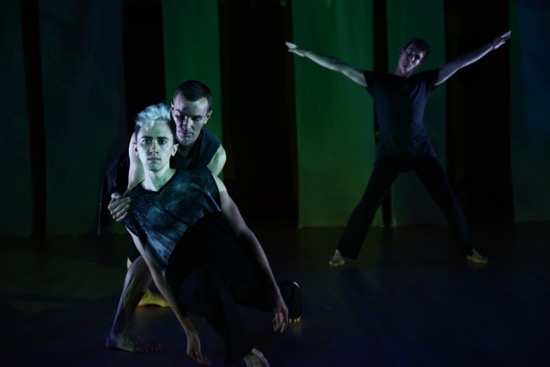
Caleb Teicher held by Branden Collwes in Sally Silvers’ Tenderizer. Dylan Crossman at back. Photo: Paula Court
I love pondering the palimpsest that is New York City. Sometimes when a building’s skeleton is all that’s left, you lay what you know of its past over its present. The eye-level, horizontal strip of a Bleecker Street window that once displayed antique toys has vanished under the big-deal plate glass that’s there now, fronting shoes. I found crumpled 1920s newspapers when I disinterred a fireplace under layers of plaster in my years-ago apartment.
Waiting for the crowd to straggle into Roulette to see dances by Sally Silvers, I’m sitting on what seems to be a large forestage—maybe not all of it dating from the space’s construction in 1928, when this was the concert hall of a well-equipped Brooklyn YWCA. Tonight, the proscenium arch frames us, while we look past the now seatless space to the u-shaped balcony, ornamented with a silvery band of a bas-relief that alternates garland framed urns and winged women in floating garments. A dainty contrast to Silvers’ keen-witted, earthier dance designs— although not, to my mind, as delectable.
The palimpsest image is not that far-fetched when watching Silvers’s new Tenderizer, which owes much of its imagery to a skewed mining expedition into three Alfred Hitchcock thrillers: Marnie, The Birds, and Psycho. That, however, is the evening’s closer, and the two pieces preceding it are meatier than the opening number and divertissement you might once have expected in this theater.
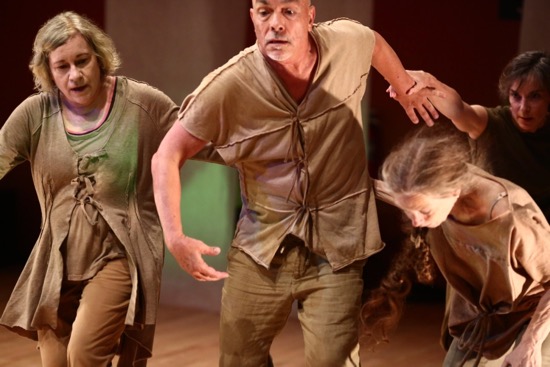
The Big Now. (L to R): Sally Silvers, Paul Langland, Kathryn Ray, and Jamie Di Mare. Photo: Paula Court
The first of the three pieces featured in the performance billed as “[Dance Roulette] Sally Silvers and Dancers: Tenderizer” is called The Big Now. The “now” is a giveaway. This quartet is a structured improvisation by Jamie Di Mare, Paul Langland, Kathryn Ray, and Silvers, wearing outfits in muted earth colors by Elizabeth Hope Clancy. These are not gifted young dancers, but seasoned pros—nimble in mind and body. Periodically, they assemble in one or another corner of the performing area and, as they advance in a squad along a diagonal, erupt into new strategies. Meanwhile, Bruce Andrews’ sound score and musician Michael Schumacher’s keyboard contributions badger them with changing sounds, volumes, textures— enhancing the atmosphere of wariness and watchfulness. The words and phrases we catch on the fly can be disorienting (“Who’s the cupcake?” “Creeping angel”. . .did I hear those correctly?). Ursula Scherrer’s mutable video design peppers the walls and the white panels she has hung from the balcony.
Episodes with the sheen of mini-dramas surface and sink again in the performance I saw. Ray has some kind of fit, and the others help her pull herself together. Langland is lifted and ejected from the group; they lay him out, lie down themselves, then rise and help him up. But these are isolated moments. The dominant image is these performers’ physical closeness to one another. Most often, they tangle and weave and dart through and duck under a bramble of arms and legs, whether the entity they comprise stays on one spot or travels around in the space. Wily dodgers, they nevertheless enable or copy one another’s moves—a model of cooperation, teased by daring.
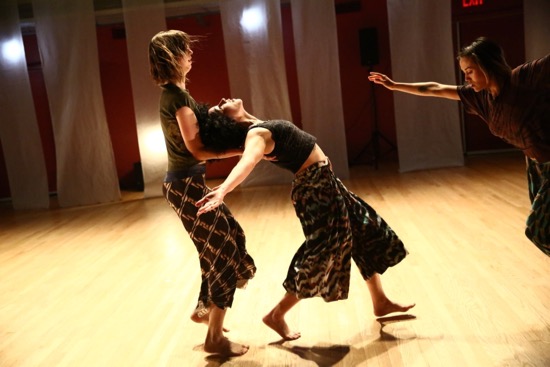
(L to R): Lindsey Jones, Veraalba Santa, and Alicia Ohs in Sally Silvers’ If You Try
When you watch Silvers’ imaginative choreography, nothing seems usual or easily predictable. Yet neither does it announce itself as importantly weird. And it’s always wonderfully organized. If You Try offers at the outset a theme of sorts; it’s one I associate with paired ice skating (partners side by side, crossing arms to grip right hands and left ones). Lindsey Jones, Alicia Ohs, and Veraalba Santa, of course, do nothing as basic as that; their arms link in more creative ways, which change as the three travel together but don’t interfere with the immaculate unison of their busy feet.
Clancy has garbed the women in black tops and flared, flamboyantly patterned pants, Whether they’re working in unison or canon, alone or in a twosome, their dancing is precise but not “refined.” That is, they may move in clearly defined patterns, but they still look impulsive. Silvers invites us to watch Jones’s long lanky body kick into movement, to take in Oh’s scampy boldness and the juiciness of Santa’s dancing. Big, demanding steps mingle with small gestures, sharp ones with smooth ones; some repeat over and over; others slide in and slip away. It’s almost a shock when the three turn perfectly synchronized cartwheels. Briefly, Jones and Santa seem at odds, then Santa “fixes” her colleague, the way a mother might check her daughter’s collar and buttons before sending her to school.
The music for If You Try seems less deliberately fragmented than that for The Big Now, but it’s also full of sudden contrasts (at one point, for instance, repetitive, percussive patterns yield to a screaming vocalist). Tenderizer, however, is a supercollage on all fronts. Projected film clips from the Hitchock movies edge the space at either side, their images dissolving into one another or suddenly cutting in. Andrews’ sound score borrows aural material from them (I think) but also creates an ambiance of non-specific dread. Silvers’ choreography imaginatively recycles, dissects, and mingles images from the films, without trying to tell their stories.
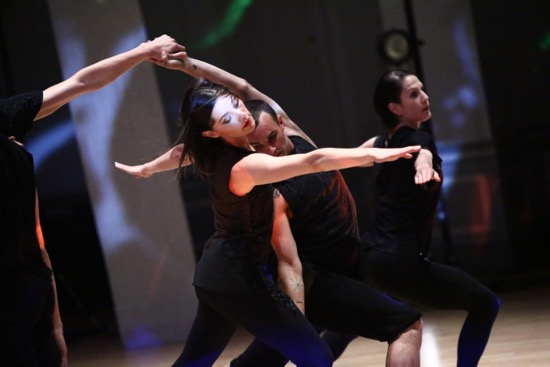
Sally Silvers’ Tenderizer. Identifiable (L to R): Melissa Toogood, Brandon Collwes, and Alexandra Berger. Photo: Paula Court
Tenderizer (what a title!) is performed by a cast of experts (three of them onetime members of Merce Cunningham’s company): Alexandra Berger, Brandon Collwes, Dylan Crossman, Jones, Caleb Teicher, and Melissa Toogood. You mightn’t recognize Toogood and Jones at first, because they move for quite a while with their backs to us, perhaps watching, as we do, a filmed woman walking away from us, along the platform of a train station.
Out of its original context, the filmed action is both concrete and mysterious. Hands open a wallet. A gloved hand pushes a key through a grating. A hand brushes a child’s long blonde hair. Janet Leigh, frantic, drives a car through the night. We see the sign for the Bates Motel and feet belonging to a body being dragged out of a shower. We see film credits. When Crossman and Collwes tip Teicher over, then lift him high, he looks at us as if we were negotiating his closeup.
You don’t need to have seen all three movies to understand the atmosphere of terror projected both by the projections and by the dancers’ way of staring around them—wary, hunted. Or to realize that, for instance, lighting designer Joe Levasseur’s sudden flashes of red were inspired by Marnie’s mysterious color visions. Or that, at some point, the dancers—bent over, elbows out, hands flapping—evoke those hostile birds that scared Tippi Hedren almost to death.
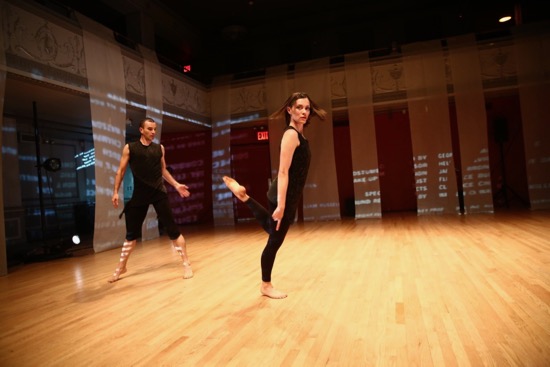
Brandon Collwes and Melissa Toogood in Tenderizer. Photo; Paula Court
Watching the action, I don’t attempt to create narratives, but I feel their lurking presence. Something must have convinced Crossman, Collwes, and Toogood to progress in a weird crawl, hands linked. Some scrap of a story made Jones and Berger bend Collwes over and position him. What are they all seeing when they look up? What impelled a crazed jump just before Crossman pairs up with Jones and Teicher with Berger in simultaneous impassive duets? Just after the Bates Motel sign appears, Crossman puts his hand over Berger’s nose and mouth and moves her close to Jones, puts his other hand over Jones’s nose and mouth and kisses the hand. Then he carefully manipulates the muzzled women. I can’t adequately describe all the ingenious ways in which these terrific performers depict complicated relationships and bondings that you can’t imagine working. They fleetingly embody not just characters in a story, but the tangled ways in which mysteries themselves unfold, knot up, or mislead you.
Imagery from The Birds dominates the last part of Tenderizer, but the very end is a fine solo for Collwes. While the projected black-and-white showerhead hints that we might ally him with Anthony Perkins in Psycho, he doesn’t perform a psychotic killer; he just presents an image of power and complexity and deviance that could—almost— map that character’s image of himself.
In the program Silvers thanks all her colleagues, but mentions the dancers’ “willingness to try it all, contributions to the movement, problem solving, and incredible talent.” Indeed.
